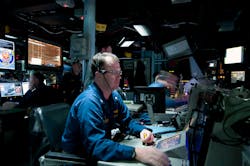Lockheed Martin to upgrade shipboard electronics in Aegis combat system aboard Navy Burke-class destroyers
WASHINGTON – Shipboard electronics experts at Lockheed Martin Corp. will replace and upgrade combat systems computer hardware, middleware, and firmware for existing U.S. Navy Aegis cruisers and destroyers under terms of an $67.4 million order announced late last month.
Officials of the Naval Sea Systems Command in Washington are asking the Lockheed Martin Rotary and Mission Systems segment in Moorestown, N.J., to handle Aegis combat system engineering agent (CSEA) efforts to design and integrate Aegis combat system Advanced Capability Build (ACB) 20.
The Aegis combat system uses powerful computers and radar to track and guide weapons to destroy enemy targets. More than 100 Aegis-equipped ships have been deployed in five navies worldwide. Aegis, not an acronym, refers to the shield of the mythical Greek God Zeus.
This order to Lockheed Martin is part of the Aegis Modernization (AMOD) program to upgrade Aegis computers through the ACB process. Aegis, developed in the 1980s, integrates the AN/SPY-1 radar, MK 99 fire control system, weapons control, the command and decision suite, and SM-2 Standard missile family, which includes the basic RIM-66 Standard, the RIM-67 extended range missile, and the newer RIM-161 designed to counter ballistic missiles.
Aegis ACB-20 involves developing the system's baseline 9C hardware and software, including Lockheed Martin's multimission signal processor that enables Burke-class destroyers to switch between their missile-and air-defense roles.
This new software and hardware is part of the future AN/SPY-6 radar, which uses X- and S-band radio frequencies to track long-range exoatmospheric ballistic targets simultaneously with close-range air and surface threats. Aegis ACB-20 also integrates the SM-6 and Evolved Sea Sparrow Block II missiles for air defense and terminal ballistic missile defense.
Aegis was developed by the Missile and Surface Radar Division of RCA, which after a series of acquisitions became part of Lockheed Martin in 1995.
Related: Navy ship building and shipboard electronics strive to do more with less
Lockheed Martin's previous work in Aegis ACB 16 involved integrating additional capabilities into the Aegis weapon system, such as ballistic missile defense (BMD) 5.1, which integrates a 21-inch-diameter variant of the SM-3 missile called the SM-3 Block IIA. BMD 5.1 also will improve Aegis data links to enable engage on remote track data.
Lockheed Martin's ACB-16 work also integrated the SPQ-9B surface search & fire control radar into the Aegis weapon system. The SPQ-9B detects and tracks incoming targets at sea level, on the surface of the water for either gun fire engagement or navigation.
Previous Aegis work also integrated the Lockheed Martin MH-60R Seahawk anti-submarine warfare (ASW) helicopter into the Aegis system, as well as improves the system's electronic warfare (EW) capabilities via the Surface Electronic Warfare Improvement Program (SEWIP).
Related: Lockheed Martin to upgrade Navy SEWIP shipboard electronic warfare (EW) systems
Lockheed Martin experts also will expand the Tactical Data Link (TDL) capability with Link 22 on the Aegis system for improved interoperability, and improve shipboard training capability through Total Ship Training Capability (TSTC).
Previous ACB Aegis upgrades installed commercial off-the-shelf (COTS computers to enhance warfighting capabilities such as simultaneous anti-air warfare and ballistic missile defense.
On this contract modification Lockheed Martin will do the work in Moorestown, N.J., and should be finished by December 2020. For more information contact Lockheed Martin Rotary and Mission Systems online at www.lockheedmartin.com, or Naval Sea Systems Command at www.navsea.navy.mil.
